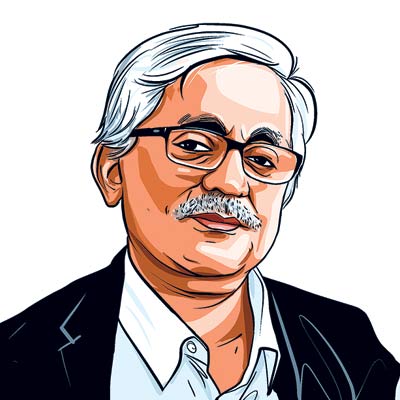Opinion Ananda Vikatan row: If we get too touchy about cartoons, we will shrink our leaders’ space in history
Bill Clinton is remembered through a popular video that sums up his two-term presidency in 24 cartoons, not all equally unflattering.
 Prime Minister Narendra Modi speaks as US President Donald Trump listens during a news conference in the East Room of the White House, Thursday, Feb. 13, 2025, in Washington. (AP Photo/Ben Curtis)
Prime Minister Narendra Modi speaks as US President Donald Trump listens during a news conference in the East Room of the White House, Thursday, Feb. 13, 2025, in Washington. (AP Photo/Ben Curtis) Thanks to the cartoon, lightning has struck Ananda Vikatan a second time. Access to the digital edition of this 100-year-old popular Tamil periodical seems blocked after the state’s BJP leaders demanded a ban on a cartoon it carried showing Prime Minister Narendra Modi in chains sitting alongside a triumphant President Donald Trump.
In 1987, the publication got into bigger trouble over a cartoon that didn’t target anyone in particular. The drawing showed two non-specific public figures and the caption said, “The one who looks like a pickpocket is the MLA and the other who looks like a dacoit is the minister.” The Tamil Nadu Assembly sent editor S Balasubramanian to jail for a three-month term, eventually cut short on second thoughts ascribed to the then CM, the all-powerful M G Ramachandran.
The state then had no dearth of all-powerful leaders. Speaker Paul Hector Pandian, who presided over the sentence and acquittal of the editor, was most vocal on the “sky-high powers” of the Assembly Speaker. He said none, including the judiciary, could question him. What has changed in the last 38 years?
Everybody swears by the Constitution in its 75th year. Such longevity is a record, most countries have had Constitutions that didn’t last two full decades. Ours became the wordiest when it was drafted, because our founding fathers were open to the world’s best constitutional practices. Back then in the tariff-free world of ideas, we imported generously from the American document. We imbibed a range of rights including free speech, short of their First Amendment, which explicitly guarantees press freedom — a bit under the cloud in these Trumpian times, but far from eclipsed. Recently, The Washington Post’s Ann Telnaes quit over a cartoon that targeted Jeff Bezos, the newspaper’s owner, not the country’s leader.
American cartoonists are unlikely to be punished for showing their President in chains. At this rate, an Indian cartoonist might be. Can we show a shackled Trump in our cartoons? In the interests of parity and reciprocity, you can’t have double standards. Also, how can you offend a vital global ally? The only glitch is that with such benchmarking, authorities here will have to block not just our cartoons but a whole range of American web cartoons.
These are not the best of times for cartoons even in the US. However, the comic art is not just entertainment but central to the country’s history. Benjamin Franklin, one of its founding fathers, was the country’s first political cartoonist. He conveyed the historic “Join or die” message to British colonies through a woodcut in 1754 that showed a severed snake.
Cartoonists there do worse things to their leaders than chaining. Long before he was president, in a 1954 Herblock cartoon, Richard Nixon climbed out of a sewer. A more sanguine Bill Clinton was attacked for a variety of lesser crimes including questionable fundraising. A cartoon showed him asking his pet cat Socks to make way for fat cats in the White House.
After all these years, Clinton is remembered through a popular video that sums up his two-term presidency in 24 cartoons, not all equally unflattering. Archival cartoons mark history. If we get too touchy about contemporary cartoons, we will eventually shrink our leaders’ space in history. Imagine a long-serving PM like Modi ending up with fewer prime ministerial cartoons than I K Gujral, H D Deve Gowda or Gulzarilal Nanda.
most read
In the case of Vikatan, there is the added issue of hurting Tamil sentiments. The Tamil cartoon was originally promoted by the language’s much-loved poet, Subramania Bharati. In exile in French Puducherry, he brought out from 1906 to 1910 India, a weekly which ran anti-British cartoons on the cover. He valued cartoon art so much that he himself would often pose for his artist to get the anatomy right.
Since then, the cartoon became an essential part of Tamil newspapers and magazines. The print version of Ananda Vikatan almost always had a cover cartoon in colour. Even the star politicians from Chennai’s studios – M G Ramachandran, Jayalalithaa, N T Rama Rao – who had image-driven careers, didn’t resent being caricatured.
Finally, a fine appreciation of cartooning can be seen in a nine-page Madras High Court judgment. Freeing the cartoonist and the publisher from defamation charges, Justice G R Swaminathan of the Madurai Bench in 2018 went into global cartooning history and our own traditions of satire to state categorically that the cartoonist has the right to ridicule, not just mock.
ep.unny@expressindia.com






